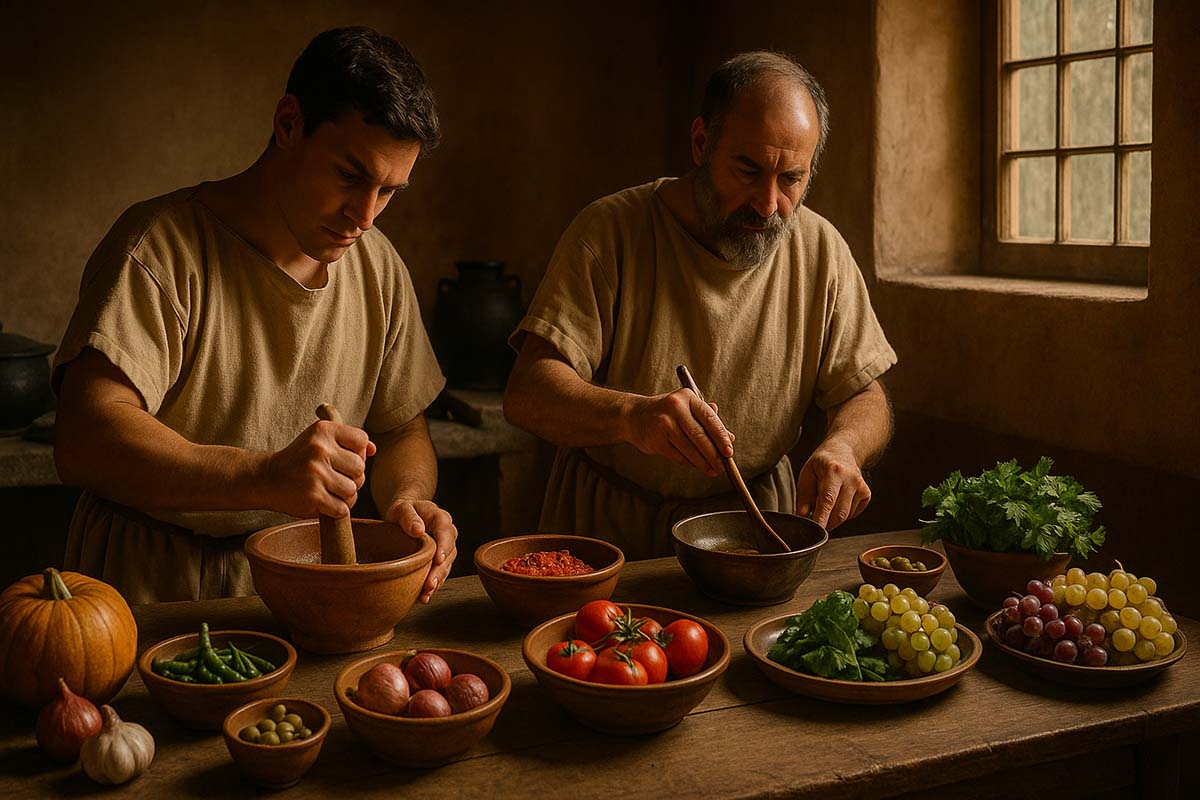Roman Cooking Tools and Their Influence on Food Culture
Just steps away from Hadrian’s Wall, visitors can still catch a whiff of bread rising inside a clibanus, the echo of a patera striking stone, and the smoke of charcoal blending into the air. For history enthusiasts, chefs, and storytellers, this subject connects the world of ancient Rome to modern dining tables. It bridges archaeological finds in Cumbria—pots stamped with legion marks and communal cookware—to the global conversation about the roots of our food traditions.
Flavors Echoing from the Past
Each bite of modern pizza or tapenade carries traces of ingredients smuggled from Italy to Britannia. Soldiers stationed at Vindolanda brought with them gustum—an appetizer rich in garlic and parsley—to stimulate the appetite before drinking. This wasn’t just flavor; it was a daily ritual binding families, troops, and traders. Over time, these practices intertwined with local traditions, creating a fusion of tastes that survive today. Revisiting their cooking tools also reveals how culinary technology advanced alongside Rome’s growing empire.
Trade, Expansion, and Culinary Exchange
The story begins in the 2nd century BCE when Rome needed to feed its growing army. Upon conquering a region, they quickly built sturdy networks of roads and ports to transport grain from Egypt, oil from Hispania, and wine from Gaul. These trade routes were not merely economic lifelines but carriers of food culture. Cooking tools followed suit: the mortarium crafted from brightened clay, or the copper sartago layered against rust. As Romans encountered new cultures, they adapted local metalwork and pottery styles, embracing foreign craftsmanship while maintaining Roman sensibilities. Today, visitors can observe nearly identical artisan marks on cookware unearthed in Cumbria and showcased in museums across Europe.
Essential Kitchen Tools That Shaped an Empire
These seemingly simple tools revolutionized Roman kitchens, empowering both the elite and commoners to prepare elaborate meals. Dishes like isicia omentata—an early version of the hamburger—became accessible across different social classes, demonstrating how culinary advancements often go hand-in-hand with societal change.
Cooking Techniques and Flavor Mastery
Romans preferred the tripod method to control flame intensity. It allowed them to adjust cooking speed by raising or lowering the pot. Cato once said that food without spice resembled “an army without courage,” highlighting the Romans’ unwavering commitment to flavor. Pepper, an expensive import from India, became a staple despite its cost. Instead of adding spices at the end, Roman cooks incorporated piper longum into the oil early on. This method resembled the foundation of modern sofrito—heating oil, adding aromatics like onions, and allowing them to meld with meats slowly, deepening flavor without burning.
Daily Meals and Social Stratification
Roman daily meals reflected their societal structure. Ordinary legionaries carried simple fare: bread loaves, dried cheese, and posca—a mix of vinegar and water. These foods were practical, nutritious, and easy to transport during military campaigns. In contrast, Roman officers enjoyed grand feasts characterized by multiple courses. Their meals often started with salads dressed in colatura, moved to hearty roasted pork infused with eastern spices, and ended with sweet raisins soaked in wine. Despite the stark differences in ingredients, both ranks relied on essential tools like mortaria and patera, proving that cooking implements remained a great equalizer across classes.
Regional Adaptations Across the Roman Empire
As Rome expanded its reach, culinary adaptations followed. In the northern territories, resourcefulness dominated kitchens. Nettles and barley often enriched their soups, replacing Mediterranean ingredients that were harder to acquire. Meanwhile, in the south, saffron and oregano flavored meals with vibrant intensity. No matter the geography, garum remained a unifying ingredient. This pungent, fermented fish sauce became the secret behind the deeply savory taste in most Roman dishes. Transported in sealed amphorae, garum traveled the vast distances of the empire, ensuring that even remote outposts maintained a taste of Roman identity.
Nutrition, Health, and Ancient Wisdom
The Roman approach to nutrition went beyond mere sustenance. Pliny the Elder praised olive oil not just as a culinary staple but as a remedy for sore muscles and dry skin. Soldiers routinely applied olive oil after rigorous training to aid recovery. Apicius, one of Rome’s most famous gastronomes, documented preservation techniques in “De Re Coquinaria.” His methods for extending the shelf life of meats involved curing with salt and vinegar, demonstrating an intuitive grasp of food science. Vinegar, by lowering the pH of food, slowed bacterial growth, an early form of food safety centuries ahead of modern refrigeration.
Modern Echoes of Ancient Practices
Contemporary culinary movements have rekindled interest in ancient cooking methods. In cities like New York, Barcelona, and Manila, chefs are revisiting Roman recipes, blending them with modern techniques. Some restaurants slow-cook pork belly using methods inspired by the testum, substituting charcoal with ceramic kamado grills for precision heat control. Artisans craft mortaria-inspired mortar and pestle sets, which now populate farmer’s markets and upscale kitchens. Food influencers attempting #AncientRomanRecipe challenges not only replicate ingredients but embrace ancient preparation techniques, bringing history to life through taste and touch.
Sharing Culinary Heritage with a New Generation
A growing trend among educators and historians is using food artifacts to teach history. At the Carlisle Museum, visitors marvel at the craftsmanship of patella cookware etched with legionary symbols. Through technological advancements, 3D models of Roman cooking tools are now widely accessible. Schools from Kenya to Peru can download, print, and explore these reconstructions, offering students a tactile connection to ancient life. This bridging of ancient and modern worlds highlights the enduring power of food as a cultural artifact.
Enduring Lessons from Roman Kitchens
While kitchens today boast electric stoves, programmable ovens, and a vast selection of spices, the wisdom of the Romans endures. Their approach emphasized that technology should enhance, not overshadow, the heart of cooking—care, flavor, and community. Every meal prepared with attention and passion carries forward this legacy. As time advances and methods evolve, the Roman spirit of gathering loved ones around a well-prepared meal remains timeless, proving that authentic cooking is not bound by era or innovation.
